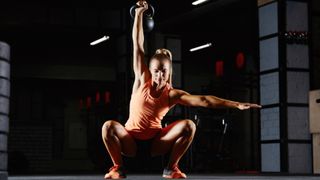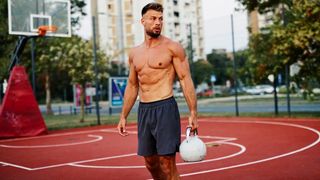I’ve put together a short but effective 15-minute kettlebell workout that works great as a fiery finisher or as a standalone kettlebell conditioning routine.
I love training with the best kettlebells. They take some skill to use — I strongly recommend learning how to hold a kettlebell properly — but once you learn proper technique with them, they’re the most fun of all the free weights to work with.
This routine aims to build stronger muscles, strengthen your core, improve core stability and build power and endurance into your training. Here’s how to do the 15-minute kettlebell workout in full, plus reasons I recommend it.
What is the 3-move kettlebell workout?
I like to use 10kg weights (roughly 22lbs) for the moves below. Choose a weight that feels challenging but allows you to complete the reps with proper form.
The workout:
40-30-20-10-5
- Kettlebell thrusters
- Butterfly sit-ups
- Suitcase deadlifts
Perform 40 reps of the thrusters, sit-ups and deadlifts, then move through 30 reps, and so on until you reach the 15-minute timer or finish all reps. If you finish way before the end of the 15 minutes, work backward up the ladder again.
These three moves build stronger hips, glutes and legs, shoulders, arms, back and chest muscles. Plus, the routine comes with a side of core work to build power and stability in these powerhouse muscles that help drive each movement.
Kettlebells allow total free range of motion so that you can move in a natural way, which can improve your functional strength and increase balance, coordination, and power. Move with control and avoid rushing the reps.
If you find yourself flying through the reps, increase the load. On the flip side, if you’re taking more than four sets to complete the first round and more than three sets to complete the second, consider reducing the load; the final three rounds should take no more than two sets per round or should be unbroken.
Unless you have an adjustable kettlebell like the Bowflex SelectTech 840 kettlebell or the JAXJOX KettlebellConnect 2.0, I recommend a smaller kettlebell with a great grip that allows you to move freely.
1. Thrusters
Thrusters are a powerful exercise combining a squat and press into one explosive move. Learn how to do thrusters with light weights before adding load, and try to keep your core engaged and back straight as you move.
2. Butterfly sit-ups
Butterfly sit-ups help isolate the core muscles by allowing the knees to sit wide while the soles of the feet press together. If your hip flexors are dominant, this sit-up variation can help you feel the move more in your abs than your hips.
Learn how to do butterfly sit-ups using just your body weight, then hold a kettlebell close to your chest using both hands or raise the weight overhead for a more challenging variation that engages your arms, shoulders and upper back.
3. Suitcase deadlifts
Suitcase deadlifts get their name from the way you pick up the weights — like lifting a suitcase from the ground. Keep your back flat, shoulders pulled back and chest proud as you grip a kettlebell in each hand, starting with the weights to the outside of your feet.
Drive up through your feet with power and stand straight before you initiate lowering the weights again. Learn how to do a suitcase deadlift step-by-step before loading heavier weights.
Trainer tips

Follow along with the videos above until you feel confident enough with your form to load. Common mistakes include leaning forward, lifting the heels and rounding the back, so keep an eye out for these weak spots.
The thrusters and deadlifts require solid connection with the ground, so I also recommend a pair of the best cross training shoes — I wear the Puma Fuse 2.0 or R.A.D One as both shoes help ground my feet and keep me supported and comfortable.
If you know sitting deep into squats is a weak spot, I’ve put together some tools to avoid buttwinking that can help address mechanics preventing you from squatting properly. You can also try adopting a slightly wider foot stance and pointing your toes 45 degrees outward, pushing your knees outward in line with your toes.
40 reps are your first and longest round, so don’t blow yourself out too early and group your reps into a few sets — 10 reps with a brief rest as a rough guideline. If you smoke yourself on the first round, moving into your 30-rep round could unravel you, so aim for consistency instead. I also like to start workouts with mobility exercises over stretches to help prepare and warm the muscles and joints for movement.
More from Tom's Guide
- I did 30 side planks with a lateral raise every day for a week — here's what happened
- No, not sit-ups — these are the two abs exercises you need to sculpt a six-pack, according to a personal trainer
- Massive Best Buy Black Friday sale live — here's 49 deals I'm recommending to family and friends




















 English (US) ·
English (US) ·